Sometimes, when examining your mouth, you may notice that a red spot has appeared on the tongue. Language reflects various pathological conditions other organs and systems of the body. The spots that appear on the surface can vary in size, shape, and cause discomfort. If they appear, you should consult a doctor, who at the appointment will explain the reason for the occurrence of the element and how to combat it.
To understand that the tongue is affected, it is necessary to compare the observed signs of damage and symptoms with the physiological structure.
Normally, the tongue is presented:
- The mucous membrane is pale pink in color;
- Filiform papillae, located over the entire area, of minimal height;
- When palpated, a slight roughness is noted;
- On the sides, in the area of the median furrow, the deposition of a small amount of plaque is visualized at the root;
- No elements in the form of papules, vesicles, erosions or ulcers should be noted.
Variants of elements that indicate a red spot in the language differ in shape and size:
- Spots with a yellow ridge;
- Petechiae: red pinpoint hemorrhage;
- Small red spot;
- Small-sized aphtha (ulcer), covered with a purulent film of plaque;
- Hard chancre (ulcer) of small size or an element noted over the entire area of the tongue;
- The spot is bluish-red;
- An element of irregular configuration, with clear edges.
Most diseases noted not only in the oral cavity, but also in other tissue systems of the body, marked by the appearance of red spots on the tongue, are often combined with other signs: increase and pain in lymph nodes, itching of the muscular organ and oral mucosa, copious amounts of grayish-white plaque on the surface of the elements.
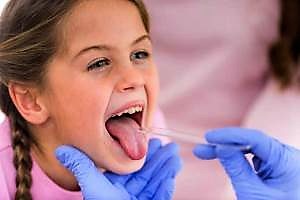
The main reasons that a red spot appears on the tongue lie in infection of the body with bacteria or viruses. Often, the origin of the element occurs during internal pathology of other organs.
Factors contributing to the appearance of spots on the tongue:
- Thermal burns and chemical solutions mucous membrane;
- Caries and its complications;
- Poor oral hygiene: abundant deposition of soft and hard dental deposits;
- Bad habits: alcoholic drinks and cigarettes contain substances that contribute to the structural restructuring of tongue tissue;
- Lollipops, mainly with high concentrations of food coloring: injury to the filiform papillae occurs;
- Infection with viruses, bacteria, fungi;
- Oncological pathology;
- Disorders of the digestive system;
- Pathology of the blood system;
- Immunodeficiency conditions;
- In response to excessive tongue cleaning during dental and oral tissue hygiene;
- Changes in hormonal balances during pregnancy.
For what ailments are the elements indicated?
Diseases in which a red spot is noted on the tongue in adults and children:
- Scarlet fever: most people get it in childhood. The disease is caused by streptococcus. Indicated symptoms: small rashes, pain when swallowing, hyperthermia. In the tongue area: there is a white coating along the midline, the mucous membrane turns pale, small red spots appear;
- Mononucleosis: in more than half of cases it is indicated on the mucous membrane of the muscular organ by petechiae. There is a sore throat, enlargement and pain in the lymph nodes, asthenic phenomena, and an increase in temperature. Required feature the disease is also inflammation in the pharynx, changes in the composition of the blood, symptoms of fever;
- Stomatitis: inflammation of the oral mucosa. As the disease develops, red spots under the tongue may develop. In other parts of the mucosa, after the formation of primary erythema, aphthae and erosions occur, on which a pale gray coating is noted. When eating, talking (if there are elements on the mucous membrane of the lips), or cleaning the mouth, you may experience strong pain;
- Moving erythema on the tongue: geographic language. The symptoms of the disease are extremely scarce. The main criterion for pathology is a peculiar pattern on the tongue in the form of “ geographical map", prone to movement (due to a simultaneous combination of desquamation and regeneration processes). The basis of the infection is an infection of bacterial or viral origin;
- Shingles: Caused by a virus. The rash is localized throughout the body. Red spots appear on the side of the tongue and in the root area and cause itching;
- Kaposi's sarcoma: caused by the herpes virus. People with immunodeficiency conditions (HIV-infected) are most susceptible. There is an increase and pain in the lymph nodes, disruption of the mucous membrane on the palate, and the appearance of a spot of bluish-red swelling due to malignancy. Suspicion of this pathology requires accurate diagnosis and quickly initiated treatment to prevent the development of complications;
- Syphilis: a sexually transmitted infection (STI). In the oral cavity, the anterior third is affected on the tongue. Hard red ulcers (chancre) appear. Consultation with a dermatovenerologist is required, the disease is contagious;
- Diseases of other organs and systems: the development of small spots with a yellow rim is often noted. It is often observed during pregnancy. From the blood side, general changes in the color of the muscle organ may be observed (the color becomes richer or the normally pink color of the tongue fades). Ailments gastrointestinal tract, For example, peptic ulcer stomach, can also lead to the development of ulcers in the mouth. Uncomfortable phenomena in the form of itching and burning are not always present with underlying diseases of the body. If symptoms are detected not only in the mouth, but also in other areas, consultation with a specialist of the appropriate profile is required.
If red or paler spots begin to appear, causing or without discomfort in the mouth, it is recommended to immediately consult a dentist for a consultation. It is necessary to remember as accurately as possible the onset of the appearance, what could have been associated with it, whether any treatment was carried out, and whether the effectiveness of therapy at home was noted.
If necessary, the doctor, conducting a clinical examination, prescribes tests that will accurately identify the cause of the formation of the elements. If red spots appear on the tongue in adults and children, this is due to pathology of other organs, and the dentist will refer you for consultation to another doctor.
Treatment of tongue spots should be comprehensive and take into account both local and general changes in the body.
Treatment tactics

- Etiological approach: after calculating the cause of the occurrence of elements through clinical and additional examination Prescribe appropriate drugs that act on the pathogen. Select antiviral, antibacterial, antimycotic;
- Prevention of the development of secondary infection: do not rub the elements, remove plaque yourself, or scratch the affected area. If prohibited manipulations are performed, wounds occur. The mucous membrane of the tongue becomes vulnerable to the microbial flora of the oral cavity. Re-inflammation occurs;
- Quitting bad habits: the oral mucosa reacts very sensitively to drinking alcohol and smoking;
- Therapy of other diseases in other parts of the body: for an illness of infectious origin, systemic use of antibiotics is prescribed wide range actions;
- STIs: chancroid should be treated together with a dermatovenerologist;
- Supervision of pregnant women: irrigation with emulsions of medicinal herbs that have anti-inflammatory and antiseptic effects. Taking solutions that strengthen the body’s immune system (green tea, honey infusions, juices from natural products);
Shingles: antiviral drugs. Treatment is carried out using antiherpetic drugs, medications for general strengthening body, vitamin complexes. To block itching, use herbal infusions (calendula with chamomile);
- Kaposi's sarcoma: after the dentist, go straight to the therapist and then undergo an oncology test. If the diagnosis is confirmed, then ionizing radiation is performed, supplementing the intervention with chemotherapy. Management of the disease is long-term and is carried out in conjunction with several specialists. If intervention is started in time, the prognosis for survival is high;
- Pathology of the digestive system: see a gastroenterologist to identify and treat the underlying disease. Correction of nutrition in the idea of assigning a special table, diet if necessary. Dysbacteriosis, indicated by diarrhea and vomiting, manifests itself under the influence of strong drugs. For correction when using antimicrobial agents, eubiotics (Bifidumbacterin) are added to therapy to restore beneficial intestinal flora;
- Refusal of irritating foods: canned foods, hot and cold foods, foods with dyes are excluded;
- Therapy for glossitis: geographic tongue can be complicated by rhomboid, hyperplastic. Intervention together with a therapist;
- Aphthous stomatitis: irrigation with antimicrobial drugs (Miramistin, Stomatidin, medicinal infusions herbs). To stimulate the immune system, Immudon is prescribed. To relieve swelling and pain in the mucous membrane of the tongue, Cholisal-gel is used. Metrogyl Denta gel has a local antimicrobial effect. Actovegin is used to block itching.
To prevent stains from occurring through infection or reinfection, it is important to follow a number of simple rules:

- Thorough oral hygiene: adequate impact on teeth, gums, and tongue mucosa. It is preferable to use a medium-hard brush to brush your teeth; for the tongue, it is better to use a soft-hard brush. An examination by a dentist should be performed once every six months;
- Maintain personal hygiene: separate dishes, bathroom accessories, washing hands, vegetables and fruits before eating;
- Rejection of bad habits;
- Strengthening the immune system: healthy lifestyle, nutritional correction (increasing intake of foods containing iron), immune drugs plant or animal origin, if necessary;
- Food for consumption should be at the optimal temperature;
- Injuries and burns in the mouth should only be treated by a dentist. Self-medication can cause complications in the body. It is necessary to understand that filiform papillae located on a large part of the tongue are difficult to restore.
The appearance of red spots on the mucous membrane of the tongue may be due to various factors. Therapeutic measures must be performed by a doctor. It is important to follow the recommendations in order to prevent complications during the development of the disease.
It is a known fact that many bacteria live in the human mouth. The human body gets along well with such microorganisms. But sometimes pathogenic bacteria enter the oral cavity that it cannot cope with. the immune system. Most often, a violation of the microflora affects the tongue, and in such cases, red formations or a white coating may appear on it. Such changes bring great discomfort to the patient, and sometimes pain. It is worth understanding why red spots appear on the tongue and how to treat the tongue.
Red spots - glossitis of the tongue
Causes of diseases with red spots on the tongue
Everyone needs to take care of their health, and therefore periodically inspect their tongue for any stains, pus or plaque. After all various neoplasms on tissues can indicate diseases.
Most often, any spots in oral cavity soon they disappear on their own, without bringing any concern with them. But sometimes a person begins to feel a burning sensation or pain, and the spots grow and begin to fester. In such cases, you should not let the disease take its course and seek help from a doctor.
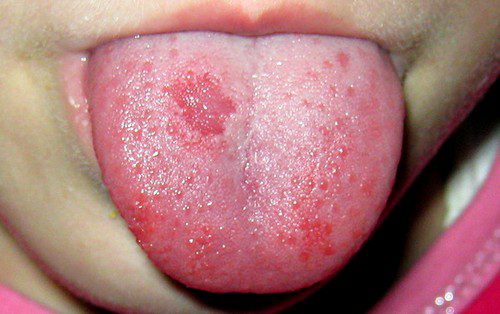
Allergy on the tongue in the form of rash and red spots
The main reasons that lead to red spots on the tissues of the oral cavity:
- burns, sometimes this happens while drinking hot drinks;
- allergic reaction to hygiene products or medication;
- tissues acquire a reddish tint when eating foods with a persistent color, this could be beets or mulberries;
- untimely eating;
- eating spicy, hot or unhealthy food;
- mechanical damage to tissues, this happens during meals or drinks;
- after tongue piercing;
- during pregnancy, some women develop red spots on their tongue;
- after visiting the dentist, bloody spots appear;
- abuse of tobacco products.
Frequent appearances of redness or swelling can lead to the formation of a tumor, then painful red dots will appear on the tongue and the inflammatory process will begin. Therefore, if red spots appear in the tongue area, and there is even a small risk of developing a hidden disease, it is important to find out the cause of such changes.
What diseases provoke the appearance of red spots
As described above, the appearance of red dots on the tongue can result in various diseases. The following diseases may lead to the appearance of red spots on the tongue of an adult.
| Name and classification of the disease | Features of the development of the disease |
| Stomatitis | This viral disease, which manifests itself in the form of ulcers that cover the entire organ of speech, and sometimes erosions are located under the rim of the tissue. Most often, this disease lasts for one to two weeks, after which complete healing of the wounds occurs. Scientists say that 20% of the world's population has suffered from this disease. The risk group includes pregnant women, in whom this disease occurs more often than others. If new ulcers appear and the old ones have not yet healed, then there is a possibility that the disease will develop into chronic form. Some types of stomatitis are contagious. |
| Oral candidiasis | This fungal disease primarily affects the mucous membrane of the throat. If measures are not taken in time and treatment is not started, the disease spreads, and first of all appears at the root of the tongue. With candidiasis, the tissue will be covered with a white coating. The disease occurs when immunity is weakened; therefore, it is more common in children and the elderly. The impetus for the development of candidiasis can be unhealthy teeth and braces. Therefore, you need to monitor your oral hygiene and visit dentists. |
| Scarlet fever | This is a viral disease. This disease occurs like a cold. A person gets a rise heat and my throat turns red. Distinctive feature Scarlet fever is a crimson shade of tissue. More often, as a result of this disease, red spots on the tongue in adults appear during a period of decreased immunity. The tissue acquires this shade due to damage to the mucous membrane by streptococcus. The tongue wears off upper layer, due to which the papillae on the tongue become clearly visible. Due to illness, the tongue temporarily loses everything taste buds. Thanks to this symptom, doctors diagnose scarlet fever. |
| Herpangina | This is a viral disease. The first signs in a patient appear in the form of fever, nausea, headache, and abdominal pain. Then many plaques appear on the entire oral mucosa, which do not exceed 7 mm. Then the plaques turn into transparent blisters, which subsequently burst, forming erosions. Afterwards, pus appears on the wounds, which is difficult to clean from the tissues. A person suffering from herpangina experiences pain when eating and swallowing, and sometimes the patient feels itching. The disease is fleeting and goes away after a week. But the person who has been ill is a carrier of this disease, and can infect another person. |
Geographic language
Children are susceptible to this disease; much less often it can manifest itself on the tongue of an adult. This disease may indicate some kind of inflammatory processes in the body. Geographic tongue can also be a consequence of a disease such as glossitis. This disease is characterized by peeling of the top layer of tissue and its cracking. The patient himself may not feel any changes. This disease cannot be treated. If it arose during characteristic age-related changes, then soon the symptoms will all disappear. If the geographic tongue has become a symptom of another disease, then it is necessary to treat this disease.
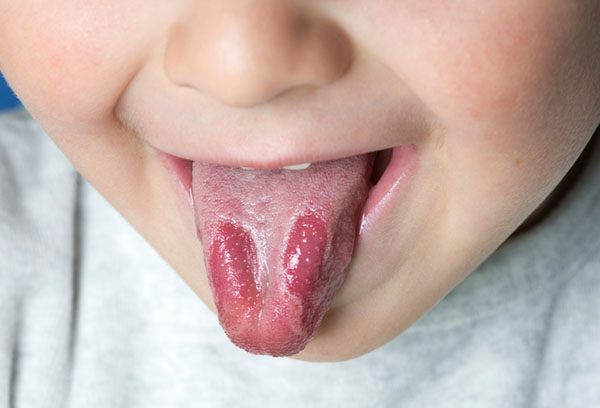
Geographic language - red spots of different shapes
Herpes virus
If the tongue is infected with the herpes virus, small pink blisters with liquid appear on the sides and tip of the tongue. If such wounds occur on the tongue, you should consult a doctor. You can cure the disease, but you will not get rid of the virus. If you follow the doctor's instructions, the disease will not bother you in the future.
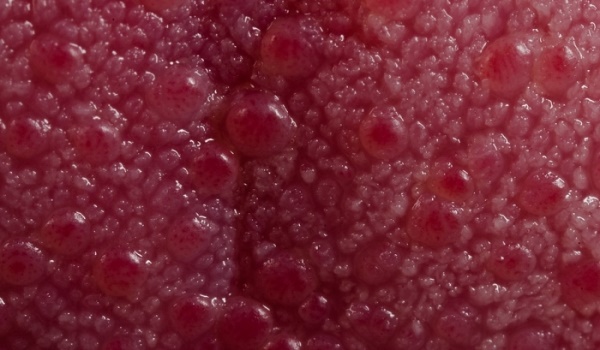
Herpes on the tongue appears first as transparent and then red spots
Erythema multiforme exudative
This is a disease of the oral mucosa. It is characterized by the appearance of red bubbles with liquid. The trigger for the onset of the disease can be mechanical tissue damage. The course of the disease is prolonged with frequent relapses. Men are more susceptible to this disease.
Traumatic inflammation
Occurs in tissues due to infection due to improperly done piercing. If red spots appear on the tongue after a puncture, there is a risk of developing inflammatory process.

Tongue injury is the cause of redness
What does the location of the red spot indicate?
Sometimes when red spots appear on the tongue, they can indicate some kind of disease internal organs a person, even a small illness gives inflammation and this can become the cause. In this case, it is important to determine the localization of the spot in order to know the health of which organ you need to pay attention to. Red spots on the tongue, causes of the following diseases:
- if a person has a red spot on the tip of his tongue, then this indicates possible problems with the heart or blood vessels;
- if the red spots are just above the tip, then the person may have problems with respiratory tract or light;
- if spots begin to appear in the middle of the tongue, then you should pay attention to the spleen;
- if the spots are just below the center, then there may be problems with the kidneys; if the root is affected, pay attention to the functioning of the intestines;
- if spots appear on the side or on the edge of the tongue, then problems with gallbladder or liver.
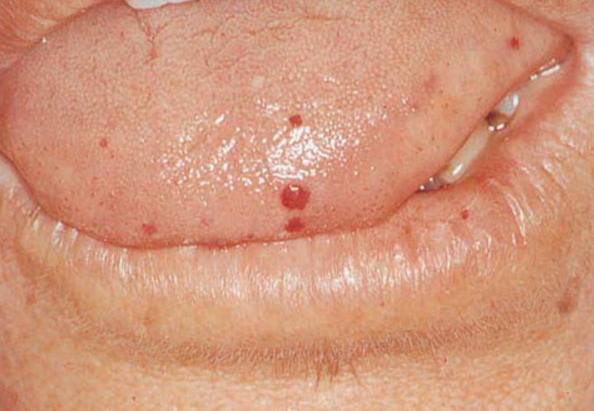
Petechiae on the tongue is a sign of internal diseases
How to treat red spots on the tongue
- If plaque and red spots appear on the tongue, then the question arises of what to do in such situations. This especially applies to those who cannot, for some reason, consult a doctor. In adults, treatment may be as follows:
- If possible, you should consult a doctor. He will be able to conduct a full examination and prescribe necessary tests. After which the doctor will make a diagnosis and prescribe the necessary treatment.
- You can't pick off wounds. Mechanical damage that can be caused in this way will only aggravate the situation.
- For diseases caused by fungal infections, I recommend taking antifungal agents.
- If oral diseases are caused by alcohol abuse or smoking, then you need to give up these bad habits. Otherwise, relapses will occur.
- If red spots appear during pregnancy, it is recommended to rinse the mouth with chamomile tincture. It has a softening and anti-inflammatory effect. It is also necessary to take medications aimed at strengthening the immune system.
- If round red spots and a coating covering the tongue appear, and the cause of this is a problem with the digestive tract, then you should completely reconsider your diet.
- Eliminate everything spicy, salty, fried and fatty from your diet. Eat more vegetables and fruits, and lead healthy image life. It is also recommended to take medications containing lactobacilli.
The next step in eliminating tongue diseases is to avoid foods that irritate the papillae of this organ.
These products include: sweets, artificial colors, preservatives. You should also avoid hot and cold foods.
But the main thing in treating tongue diseases is visiting a doctor. First, visit the dentist, he will examine the oral cavity and prescribe treatment. If this disease cannot be treated dentally, the dentist will give a referral to a therapist or other doctors. And there, depending on the suspected disease, the doctor will direct you to undergo tests or other examination.
Sometimes delay proper treatment can lead to something irreparable. After all, red spots on the tongue may be a symptom cancer, and in this case, the sooner the patient begins treatment, the greater the chance of recovery.
If the cause of red spots on the tongue is a disease of the internal organs, then diagnosis of the disease is required and complex treatment. If a person treats only the symptoms on the tongue, he will miss the main disease.
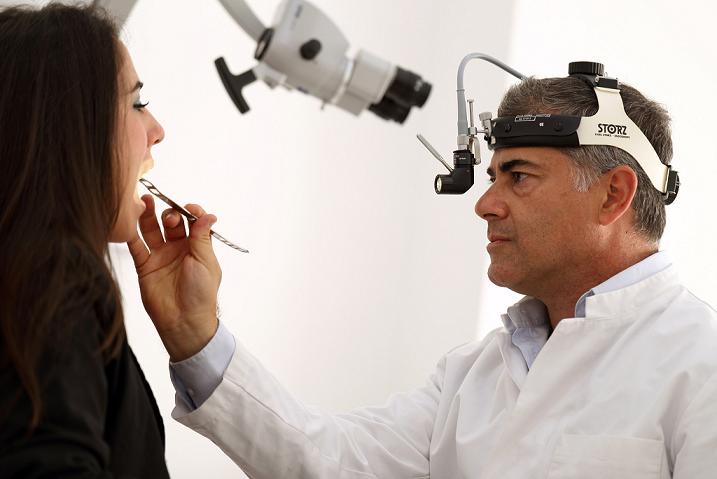
Treatment is prescribed only by a doctor
There are a number of things that should not be done during treatment of tongue diseases. They are as follows:
- Can't resort to treatment antibacterial agents. This is due to the fact that the causes of red spots on the tongue, in most cases, are viral diseases, and they cannot be treated with antibacterial drugs.
- Apply folk remedies, which contain previously untested and unknown components. Such substances can intensify allergies and aggravate the patient’s condition.
- It is prohibited to use drugs that contain alcohol. Such treatment will backfire and the tongue will be burned.
- Can not use antiseptics like iodine, brilliant green, hydrogen peroxide and other similar drugs. External wounds can be treated with such means, but not damage to the mucous membrane.
- If it is not known for certain why the illness appeared, then vitamins should not be consumed in large quantities. Since the disease could have occurred due to an excess of any trace element.
If you want the treatment to be correct, then seek help and a prescription from a doctor.
Preventive actions
To avoid oral diseases, you need to follow the following recommendations:
- Don't ignore oral hygiene. Avoid using other people's hygiene products and utensils.
- When purchasing toothpaste or tooth powder, give preference to those based on medicinal plant extracts.
- In addition to brushing your teeth, you should also pay attention to your tongue. For this, there are special scrapers, or toothbrushes, which have a special surface for the tongue.
- After brushing your teeth and tongue, do not neglect mouth rinses. They are based on medicinal herbs and have a mild antibacterial effect. And after rinsing, your breath is always fresh.
- Abuse of alcohol and tobacco products negatively affects the microflora of the mouth. Eliminate bad habits, or keep them to a minimum.
- Take medications that help strengthen your immune system. A weakened immune system cannot cope with infectious diseases.
- Eat more foods containing iron.
- Avoid eating cold or hot food and drinks.
- Make it a rule to wash them before eating any vegetables or fruits. This applies even to those fruits whose peels must be peeled.
- If you accidentally injure your tongue, you should consult a doctor.
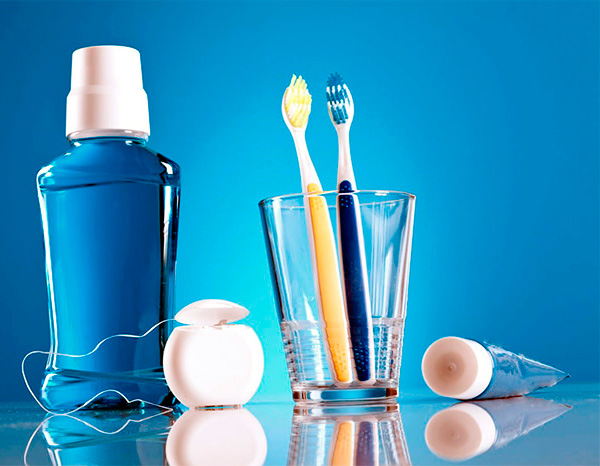
Oral and tongue hygiene is mandatory
Improper self-medication leads to disastrous effects. In the best case, taste buds are lost and the disease of the oral cavity becomes chronic. And in the worst case, there is a risk of tumors.
If you adhere to these simple rules, then no words will appear in your language. infectious diseases and your breath will always be fresh.
How to clean your tongue
Most people, after brushing their teeth, forget that bacteria also multiply on the tongue. If you ignore cleaning your tongue, this can lead to the appearance of plaque on it, and then red spots. Therefore, after finishing brushing your teeth, you should proceed to the same hygienic procedure for the tongue.
If your Toothbrush is equipped with a rubber tongue grater, then use it; if not, then it would be appropriate to purchase a tongue scraper. This hygiene procedure is especially important for those people who have symptoms of geographic tongue, or smokers.
To clean your tongue well, you need to brush several times from the base of the tongue to its tip, do not forget to grab the edge of the tongue. After this, sweep the brush horizontally. Do this procedure carefully, without pressing hard on the scraper to avoid injury. Also for greater effect. A special antibacterial gel is applied to the surface of the tongue and left in this form for a minute, after which the mouth is thoroughly rinsed.
Toothbrushes, as well as tongue scrapers, are changed every three months.
Even if you have no problems with diseases on your tongue, still periodically examine it, because if you identify the disease in time, you can quickly deal with it.
U healthy child the tongue has a uniform pink color without spots or plaque. But in the presence of any pathology, spots of various colors and sizes may appear, which represent:
- An uneven accumulation of plaque on the surface of the tongue, which consists of exfoliated epithelium, tiny food particles, and microorganisms.
- Excessive proliferation of epithelium in certain areas of the mucous membranes.
- Limited inflammation.
- Benign or malignant neoplasms.
Let's look at the main reasons for the appearance of various spots and methods of treating them.
White
In a baby, the appearance of white spots on the tongue most often indicates thrush - fungal infection mucous membranes against the background of decreased immune defense in the body or when taking antibiotics. Such spots are located asymmetrically, can have a variety of sizes, and are often covered with a cheesy coating.
If a child shows signs of thrush on his tongue, then it is necessary to visit a pediatrician who will find out the reasons for its appearance. Delay in treatment can cause progression of the disease and inflammation of the mucous membrane, which will cause pain and discomfort in the child. You cannot try to remove the plaque on your own; this can lead to additional trauma. To eliminate such white spots, it is most often recommended to treat the child’s oral cavity with a weak solution. baking soda or regular greenery. In more severe cases and with relapse of the disease, it may be necessary to take antifungal drugs.
Geographical
If red spots and a white coating along their edges appear on the tongue, then this is a sign of a geographic tongue - desquamative glossitis. The disease is not inflammatory in nature and may indicate some hormonal disorders, about worms and problems in digestive system. Such spots do not have smooth outlines, they quickly change their location and do not bother the child in any way. They can be oval, round or have fancy shapes.
In the photo: geographical spots on the tongue of a 10-year-old child
This disease lasts a long time and often goes away on its own after some time, even without specific therapy. Sometimes antiseptics, vitamins and drugs that accelerate tissue regeneration processes are used to treat geographic tongue. But most experts (for example, Dr. Komarovsky) believe that there is no need to treat geographic spots.
Yellow
Problems with the gastrointestinal tract in a child often cause yellow spots on the surface of the tongue and at its root. Such spots are covered with a dense coating of desquamated epithelium, which is difficult to remove from the mucous membrane. They are often accompanied by the appearance unpleasant odor from mouth. Specific treatment no such formations are carried out. Elimination of diseases of the stomach and intestines leads to the rapid disappearance of such yellow spots.
Reds
The appearance of red spots on a child’s tongue is a sure sign of an infectious or inflammatory process in the oral cavity:
- stomatitis;
- bacterial dermatosis;
- herpetic infection.
Also, red spots may be due to an allergic reaction or consumption food products having a bright red color.
Very often such formations are accompanied unpleasant symptoms: pain in the tongue, feeling of discomfort, increased salivation. Due to pain, children may be capricious and refuse to eat or drink. May suffer and general state- body temperature rises.
Only a doctor should treat red spots. After establishing an accurate diagnosis, the following may be prescribed:
- treatment of lesions with antiseptic agents;
- taking antibiotics or antivirals;
- use of anti-inflammatory medications.
Dark
Dark spots on the tongue often occur when eating food that contains dark pigments that color the plaque on the surface of the mucous membranes. Such spots do not pose any danger to the child and disappear after hygiene procedures. But there are a number of conditions that manifest as dark spots in the mouth and which can have very serious consequences.
Black
Black spots on the tongue in children most often appear during a long course of antibiotic therapy as a result of the active proliferation of microorganisms and fungi. Blackening of the tongue develops gradually and can last up to 2-3 weeks. The main treatment for this condition is to restore normal microflora in the intestines and oral cavity of the child. For this purpose, eubiotic drugs are prescribed (for example, Linex, Bifidumbacterin, Lactobacterin).
It is extremely rare that black spots on the tongue appear as a result of deep degenerative processes accompanied by necrosis of areas of the mucous membrane. This condition is very dangerous and requires emergency medical attention. The treatment of such spots is often surgical.
Blue
Blue spots in a child's mouth - a rare event. They may appear in the following situations:
- The presence of severe heart failure due to heart disease and defects. Spots on the tongue appear due to stagnation of blood in the venous bed and are accompanied by blue discoloration of the lips and limbs. Their treatment consists of eliminating cardiac pathology and normalizing blood microcirculation in the vessels.
- With the growth of a benign vascular tumor - hemangiomas. This blue spot is most often single. Treatment is only possible through surgery.
Bald
Normally, the lingual surface is covered with a large number of small taste buds, which give it a velvety appearance. If such papillae die or atrophy for any reason, “bald” spots appear. They are pink in color, irregular in shape and do not spread to the mucous membranes of the cheeks, lips or gums.
Reasons that can cause the appearance of such pink “bald” spots:
- Inflammatory diseases (glossitis, stomatitis).
- Tongue injuries.
- Burns from heat or chemicals.
“Bald” spots do not cause any inconvenience to children, but can slightly change taste sensations. It is impossible to cure such formations, since the taste buds cannot be restored.
If you find that you have one year old child or an older child’s tongue has become spotted - you shouldn’t panic and try to treat them yourself. You should also not ignore the appearance of spots on the tongue, as they may indicate the presence of serious illnesses. It is necessary to consult a doctor who will find out the exact cause of such changes and, if necessary, select appropriate treatment for the child.
From time immemorial, examination of the tongue has been an important (and sometimes the only) method of diagnosing diseases. Today, when the presence of a particular disease can eloquently tell laboratory analysis, doctors still tell patients, “Stick out your tongue.” And this once again proves that the old method has not outlived its usefulness. Using it, even a person without medical education may suspect something is wrong in the functioning of one or another body system. Let's consider what red spots on the tongue may be associated with - a fairly common phenomenon.
Viral infectionThe reasons for the appearance of a red spot on the tongue are often associated with infection:
- – a disease of a viral nature in which the pharynx and lymph nodes are affected, fever and changes in blood composition occur. If you feel pain when swallowing, high temperature, weakness, pain when palpating the lymph nodes, and also your tongue is covered with red spots in the form of pinpoint hemorrhages (petechiae), then it is possible that the body is attacking a virus. Damage to the tongue mucosa is observed in 2/3 of cases of mononucleosis.
- Shingles- another viral disease accompanied by rashes on different parts bodies. If there are red spots on the root and tip of the tongue that itch, the cause may be Herpes zoster, a “relative” of the virus that causes chickenpox.
- Kaposi's sarcoma– is caused by the herpes virus and affects mainly HIV-infected people, manifesting itself as malignant tumors on the skin. If a red spot with a bluish tint appears on the gums, root or tip of the tongue, while the mucous membrane of the palate is damaged and the lymph nodes are enlarged, Kaposi's sarcoma can be suspected.
The appearance of specific spots on the tongue may indicate bacterial infections:
- – caused by streptococcus and accompanied by a small rash, high fever, sore throat. It occurs most often in childhood. Main sign that the body attacks streptococcus - white tongue with red spots, and they are small, while the plaque is continuous and is located approximately in the middle of the tongue (sometimes it covers the tongue completely).
- Syphilis- one of the symptoms of this venereal disease: red, hard ulcers (chancres) on the back of the tongue, or rather on its front third.
- Stomatitis, in which red spots may appear under the tongue in the form of ulcers or aphthae - small, with a purulent coating. The same damage to the mucous membrane is observed on the inner surface of the cheeks and lips; the ulcers cause severe pain, especially while eating.
With anemia (anemia), the gums and tongue become very pale, barely pink due to a deficiency of red blood cells (erythrocytes) in the body, while bright red spots appear on the tongue.
“Geographical tongue” or migratory erythema of the oral form is very rare disease, which is accompanied by the appearance of red spots on the tongue, clearly visible against the background of white rims and not causing pain. This picture resembles continents and oceans on a map, which is why the disease received a specific name. And although erythema itself is caused by bacterial or 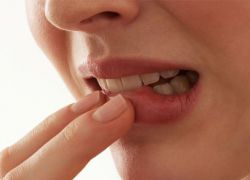 viral infection(doctors have not yet found the exact answer), “geographical language” may indicate various disorders internal organs (gastrointestinal tract or cardiovascular system, for example). Often such patterns appear on the tongue of pregnant women.
viral infection(doctors have not yet found the exact answer), “geographical language” may indicate various disorders internal organs (gastrointestinal tract or cardiovascular system, for example). Often such patterns appear on the tongue of pregnant women.
It is worth noting that healthy person language is usually Pink colour no spots or redness, a small amount of white coating is acceptable. If you see something very different in the mirror, it makes sense to seek a diagnosis from a therapist. If the oral mucosa hurts, you should visit the dentist.
Each of us has ever had various neoplasms appear on the body or on any organs, the causes of which are unknown to anyone. Moreover, neoplasms are absolutely different types and have a different character.
Some people have red dots, some have small warts, and any other formations are possible. Depending on what forms on the human body, you need to understand the cause and eliminate it.
After all, sometimes any formation on the body entails Negative consequences and may cause the development of any diagnosis.
Of course, you need to pay due attention to your health and, if various neoplasms occur, consult a doctor.
Today we will talk about why red dots appear on a person’s tongue, what are the reasons for their occurrence, is there any cause for concern and is there a need to attach special importance to this?
Let's take a closer look
Red dots on the tongue can appear in absolutely everyone - both adults and children.
What can be associated with the appearance of red dots?
- In fact, the manifestation of such points is not always the cause of any dental problems. Very often, red dots appear on the tip of the tongue and, as a rule, this is a common case. They, in turn, indicate that a person does not pay the necessary attention to oral hygiene. This is the most common reason.
- Also the appearance of red dots may be an indicator that a person has a weakened immune system, which certainly needs to be addressed.
- Cases cannot be excluded when red dots appear in those who eat seeds very often and in large quantities. Excessive consumption of seeds may cause irritation on the tongue. This is not something to be afraid of.
- Excessive food consumption elevated temperature and increased severity, may cause irritation. Is it worth paying so much attention to this and is there any reason for concern and worry?
What do red dots on the tongue mean?
Every human organ certainly gives a signal if something is wrong with it. As a rule, this usually manifests itself in various forms. For example, some sensations may form or, conversely, manifest themselves externally on an organ or human body.
A person's tongue is normal when it has a pale pink color. This color is an indicator that the tongue is normal and there are no disturbances in the functioning of the body.
Without any visible and significant violations, there are no stains and, of course, painful sensations. The only thing that is normally acceptable in the human body is the presence of a small plaque, which, as a rule, is in light colors.
Red dots on the tongue can occur absolutely various reasons. This may be a signal that there is the development of some kind of disease, the beginning of the inflammation process, and much more.
Most often, the most common cause of red dots on the tongue may be allergy. An allergic reaction usually occurs due to foods that a person consumes.
In this case, the mucous membrane is damaged and begins to react to food in the form of an allergic reaction, which occurs in the form of red spots:
- Swelling may occur.
Suppose that a person eats food that is too hot or too spicy. - Consuming excessive amounts of sugary foods and confectionery products can also lead to allergies in the tongue.
- In practice, there are also cases, when red dots appear due to increased consumption of alcohol and tobacco.
- Very often, people take different medicines , which can also be allergic reactions absolutely any person.
Pregnant women are not immune to the appearance of red dots on the tongue. However, they have nothing to worry about. These symptoms usually occur when the immune system is malfunctioning.
There is also an opinion that the appearance of red dots on the tongue indicates that the person was or is in this moment in a severe state of stress.
However, if you notice red dots on your tongue, then this is primarily a signal for you from your body. This signal from the body tells you that not everything is okay and that something is wrong.
Even if you experience any irritation, this is no longer normal.
Causes of red dots in children and adults
What are the reasons for the appearance of red dots?
Very often, doctors identify the following reasons:
- incorrectly formed bite;
- cleansing the dentition and oral cavity.
However, very often red spots appear and also disappear very quickly. Among the reasons, we can note such diseases as: mononucleosis. In the case of such a diagnosis, hemorrhage forms on the surface of the tongue, which appears in the form of dots.
They can be located and begin their development both on the hard part of the palate and on the soft. 
There are several reasons for the appearance of red dots in both children and adults:
- Appearance painful sensations in the area of the larynx;
- Difficulty breathing and increased body temperature;
- An increase in the size of the spleen and even the liver (in case of chronic pathology).
Exudative erythema
- This disease manifests itself in quite acute form . Literally within a day, a person’s body temperature rises and a sore throat is felt. A person is constantly tormented by headaches and, as a rule, they do not go away in a short period of time.
- Rashes that appear on the tongue are red spots that are located on the mucous membrane in a swollen state. Subsequently, such spots turn into bubbles that are filled with liquid.
- The problem with this disease is that that spots can spread not only on the tongue, but also on the lips. Later, the bubbles that form with the contents containing the liquid burst and ulcers form in their place.
- The appearance of such points causes severe pain in the future and may make it difficult for a person to speak, and there may also be problems associated with eating.
Kawasaki syndrome
This pathology is extremely rare, but, alas, it does occur. This disease leads to the appearance of bright crimson spots that completely cover the entire surface of the tongue.
Just like in the course of other diseases, with Kawasaki syndrome, high body temperature, lips swell and turn red, conjunctivitis becomes inflamed and rashes on the skin are possible.
Syphilis
The disease is quite common today and represents the appearance of hard red balls.
Such formations usually do not hurt and have absolutely no effect on a person’s body temperature.
Herpes zoster and Kaposi's sarcoma disease
Depriving begins its manifestation with increased body temperature. There is also severe pain in the tongue area. Ringworm usually affects the tip or even the root of a person’s tongue. Severe pain accompanies throughout the entire illness.
Kaposi's sarcoma is a type of cancer. In fact, this disease is usually diagnosed in HIV carriers. This disease manifests itself in the form of red spots with a predominant blue tint.
Red dots on the tip of the tongue
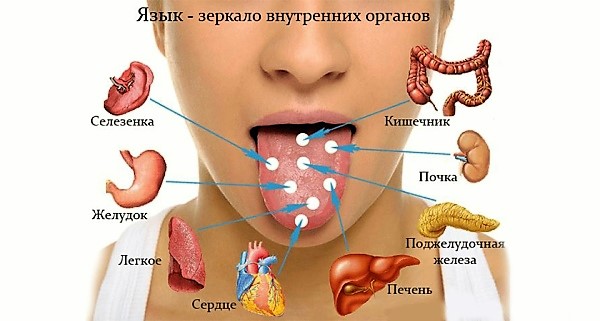
Red dots on the tongue and white coating
Very often, red dots on the tongue are accompanied by a white coating. Also, plaque can be expressed in yellowish color. If plaque appears on the root of the tongue, then this is an indicator that a person has problems with the functioning of the stomach or with the functioning of the intestines.
As a rule, this is accompanied by diseases such as:
- Chronic gastritis;
Often, white coating appears together with the odor from the oral cavity, which has a very unpleasant and pungent odor. This may also be due to the functioning of the gastrointestinal tract, and the reasons may also be hidden in the problem of the oral cavity. - Stomatitis;
This disease can also cause plaque to appear. Those who do not pay due attention to oral hygiene are also not protected from the appearance of such plaque. You should brush your teeth twice a day and rinse your mouth after every meal.
Do not confuse white plaque with deposits, which every person has and which are considered normal.
If you notice that you have red dots, consult a doctor immediately. You need to consult a doctor, as well as treatment for some time.
Yellow plaque and red dots
Often, along with the appearance of red dots on the tongue, a plaque appears yellow color. Yellow plaque just like a white person can say that there really are problems in the human body. For diagnosis, it is best to contact a highly qualified doctor and undergo the appropriate tests.
Yellow plaque may accompany the disease:
- associated with the work of the stomach;
- with the onset of gastritis.
Red dots and burning sensation
Very often, the appearance of red dots on the tongue is accompanied by burning and pain. This may be a consequence of the occurrence of different nature diseases.
Many diseases entail pain in the tongue, as well as in the larynx. In order to understand what the problem is, you need to see a doctor.
A burning sensation on the tongue is a signal that is worth paying attention to. After all, it is the burning sensation that can cause you to have a serious illness.
When are red dots on the tongue not a reason to worry?
There is no reason to worry only if you are pregnant and carrying a child. As a rule, pregnant women very often red dots appear on the tongue. This indicates that the woman has reduced immunity.
However, it is usually more related to pregnancy. In this case, you only need to take care of how to strengthen your immunity.
If you find red dots in the tongue area:
- Do not touch the formations with your hands under any circumstances to avoid infection;
- Be sure to seek help from a doctor after first observing the condition of the red dots in the tongue area;
- It is very important to maintain oral hygiene. Get into the habit of rinsing your mouth after every meal. clean water. It is necessary to brush your teeth twice a day: in the morning and respectively in the evening;
Of course, compliance with hygiene rules is the first thing you must ensure on your part. After all, infection is a very common occurrence that results in various diseases in the oral cavity.
Maintain good oral and dental hygiene and take care of your health so that problems do not worsen.








